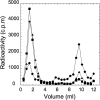Engineering viable foot-and-mouth disease viruses with increased thermostability as a step in the development of improved vaccines
- PMID: 18829763
- PMCID: PMC2593342
- DOI: 10.1128/JVI.01553-08
Engineering viable foot-and-mouth disease viruses with increased thermostability as a step in the development of improved vaccines
Abstract
We have rationally engineered foot-and-mouth disease virus to increase its stability against thermal dissociation into subunits without disrupting the many biological functions needed for its infectivity. Amino acid side chains located near the capsid intersubunit interfaces and either predicted or found to be dispensable for infectivity were replaced by others that could establish new disulfide bonds or electrostatic interactions between subunits. Two engineered viruses were normally infectious, genetically stable, and antigenically indistinguishable from the natural virus but showed substantially increased stability against irreversible dissociation. Electrostatic interactions mediated this stabilizing effect. For foot-and-mouth disease virus and other viruses, some evidence had suggested that an increase in virion stability could be linked to an impairment of infectivity. The results of the present study show, in fact, that virion thermostability against dissociation into subunits may not be selectively constrained by functional requirements for infectivity. The thermostable viruses obtained, and others similarly engineered, could be used for the production, using current procedures, of foot-and-mouth disease vaccines that are less dependent on a faultless cold chain. In addition, introduction of those stabilizing mutations in empty (nucleic acid-free) capsids could facilitate the production of infection-risk-free vaccines against the disease, one of the economically most important animal diseases worldwide.
Figures







Similar articles
-
Thermostability of the Foot-and-Mouth Disease Virus Capsid Is Modulated by Lethal and Viability-Restoring Compensatory Amino Acid Substitutions.J Virol. 2019 May 1;93(10):e02293-18. doi: 10.1128/JVI.02293-18. Print 2019 May 15. J Virol. 2019. PMID: 30867300 Free PMC article.
-
Identification of the structural basis of thermal lability of a virus provides a rationale for improved vaccines.Structure. 2014 Nov 4;22(11):1560-70. doi: 10.1016/j.str.2014.08.019. Epub 2014 Oct 9. Structure. 2014. PMID: 25308865
-
Custom-engineered chimeric foot-and-mouth disease vaccine elicits protective immune responses in pigs.J Gen Virol. 2011 Apr;92(Pt 4):849-59. doi: 10.1099/vir.0.027151-0. Epub 2010 Dec 22. J Gen Virol. 2011. PMID: 21177923
-
Development of vaccines toward the global control and eradication of foot-and-mouth disease.Expert Rev Vaccines. 2011 Mar;10(3):377-87. doi: 10.1586/erv.11.4. Expert Rev Vaccines. 2011. PMID: 21434805 Review.
-
Past and present vaccine development strategies for the control of foot-and-mouth disease.Acta Virol. 2004;48(4):201-14. Acta Virol. 2004. PMID: 15745043 Review.
Cited by
-
Interferon-γ induced by in vitro re-stimulation of CD4+ T-cells correlates with in vivo FMD vaccine induced protection of cattle against disease and persistent infection.PLoS One. 2012;7(9):e44365. doi: 10.1371/journal.pone.0044365. Epub 2012 Sep 28. PLoS One. 2012. PMID: 23028529 Free PMC article.
-
Equine Rhinitis A Virus Mutants with Altered Acid Resistance Unveil a Key Role of VP3 and Intrasubunit Interactions in the Control of the pH Stability of the Aphthovirus Capsid.J Virol. 2016 Oct 14;90(21):9725-9732. doi: 10.1128/JVI.01043-16. Print 2016 Nov 1. J Virol. 2016. PMID: 27535044 Free PMC article.
-
The rescue and selection of thermally stable type O vaccine candidate strains of foot-and-mouth disease virus.Arch Virol. 2021 Aug;166(8):2131-2140. doi: 10.1007/s00705-021-05100-3. Epub 2021 May 18. Arch Virol. 2021. PMID: 34003358
-
Thermostable negative-marker foot-and-mouth disease virus serotype O induces protective immunity in guinea pigs.Appl Microbiol Biotechnol. 2023 Feb;107(4):1285-1297. doi: 10.1007/s00253-023-12359-w. Epub 2023 Jan 19. Appl Microbiol Biotechnol. 2023. PMID: 36656322 Free PMC article.
-
Requirements for improved vaccines against foot-and-mouth disease epidemics.Clin Exp Vaccine Res. 2013 Jan;2(1):8-18. doi: 10.7774/cevr.2013.2.1.8. Epub 2013 Jan 15. Clin Exp Vaccine Res. 2013. PMID: 23596585 Free PMC article.
References
-
- Abrams, C. C., A. M. King, and G. J. Belsham. 1995. Assembly of foot-and-mouth disease virus empty capsids synthesized by a vaccinia virus expression system. J. Gen. Virol. 763089-3098. - PubMed
-
- Acharya, R., E. Fry, D. Stuart, G. Fox, D. Rowlands, and F. Brown. 1989. The three-dimensional structure of foot-and-mouth disease virus at 2.9 Å resolution. Nature 337709-716. - PubMed
-
- Ashcroft, A. E., H. Lago, J. M. B. Macedo, W. T. Horn, N. J. Stonehouse, and P. G. Stockley. 2005. Engineering thermal stability in RNA phage capsids via disulphide bonds. J. Nanosci. Nanotechnol. 52034-2041. - PubMed
-
- Barteling, S. J. 2004. Modern inactivated foot-and-mouth disease (FMD) vaccines: historical background and key elements in production and use, p. 305-334. In F. Sobrino and E. Domingo (ed.), Foot and mouth disease. Current perspectives. Horizon Bioscience, Norfolk, United Kingdom.
Publication types
MeSH terms
Substances
LinkOut - more resources
Full Text Sources
Other Literature Sources

